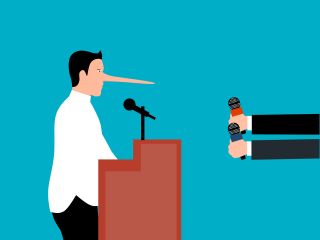Deception
The Language of Deception
Is there such a thing as a linguistic lie detector?
Posted May 14, 2023 Reviewed by Jessica Schrader
Key points
- Humans are not very good at detecting deception.
- Recent work has looked to verbal clues that might help indicate someone is lying or telling the truth.
- Verbal indicators including filled pauses, word count, and word diversity look promising.
Despite our tendency to view modern politicians with skepticism, George Santos shocked even the most hardened among us with the breadth and depth of his alleged lies. More disturbing still is how long it took to uncover the false tales he apparently spun, even though much of what he claimed should have been relatively easy to verify, such as his school and work history. But our tendency to believe what speakers say is tied to the underlying rules that guide us to be cooperative conversationalists, with most of us assuming that such cooperation includes telling the truth.
Unfortunately, this tendency makes us quite bad at sensing when someone is lying. Research shows that humans perform only slightly better than chance at detecting deception, even with training. And Santos may be living proof of both our propensity to take speakers at their word and our failure to be sensitive to behavioral indicators that someone is lying.
But the fact that we are not able to recognize it when someone lies doesn’t mean they don’t leave clues to their dishonesty. In that vein, researchers have been trying to determine whether liars—or truth-tellers—have certain linguistic “tells." Can studying language use reveal whether someone is being deceptive?
Um-truths
Quite a bit of psycholinguistic research has examined how filled pauses, those ums and uhs that pop into our speech, are triggered by cognitive load or retrieval processes when we are constructing sentences or searching for words. But some psychological research suggests that they could also be flags of a speaker’s veracity.
People tend to use filled pauses when they are describing something new or choosing among competing vocabulary words or constructing a new sentence, all things we are doing when having a spontaneous conversation with someone. However, when people rehearse or practice what they are planning to say, they typically produce fewer ums and uhs.
So, if we assume liars have rehearsed a lie prior to telling it, we should expect to see fewer filled pauses. Conversely, unpracticed speech should have more. Since filled pauses are also often perceived as indicating someone is less certain about what they are saying, liars might also try to inhibit ums and uhs so that they do not appear hesitant about what they are claiming. On the other hand, the greater cognitive load of having to monitor one’s responses more when lying to make sure something inconsistent doesn’t slip out could encourage greater filled pause use.
Though a number of studies have reported a significant relationship between the use of filled pauses and truth-telling, they have not been consistent in the direction of the findings, with some research finding that liars use fewer filled pauses and others finding they use more. Much of this inconsistency appears to be related to what counts as a filled pause (some group filler words such as ‘like’ in with filled pauses) and what kind of lie is being told (a spontaneous lie which would require more cognitive processing or a rehearsed prefabricated lie).
Overall, and if narrowed down to the use of um exclusively, it does appear that speakers use fewer filled pauses when lying compared to when telling the truth. Presumably, having practiced a lie before you say it makes you less likely to produce markers of hesitation. This difference in the rate of um, though, is often very subtle and not a very reliable cue to deception on its own.
Watch what you say
Research on deceptive language has also looked at word count and word type as indicators of deception. The assumption is that because lying does not rely on rich encoding of actual experience, lies will be less specific and less descriptive. As well, since liars are attempting to conceal their dishonesty, they tend to be less detailed and less wordy. In short, saying less lets one get away with more. In a meta-analysis of studies that looked at correlates of deception, the general finding is that liars use fewer words than truth-tellers.

But it seems that liars don’t just use fewer words overall, they also use less diversity in terms of which ones they choose. In other words, those telling the truth show a greater range of diverse content words than those telling lies, a finding that has been hypothesized to relate to the burden on working memory and increased cognitive load when telling a lie, since you simultaneously have to construct the lie and suppress the truth.
Research has also looked at variation in the use of words that express certainty (or the reverse, uncertainty). Words such as “always,” “absolutely,” or “never” are more committed and certain than words expressing doubt such as “maybe” or “possibly.” While it might seem that liars would be less likely to use strong language when what they are saying is false, findings on word choice instead suggest that liars tend to favor more certain language, presumably so that they come across as more credible.
A recent meta-analysis has also indicated that truth-tellers tend to include more verifiable details than liars do (e.g., such as being somewhere with witnesses rather than being home alone), as details that can be checked for veracity put liars at risk of being discovered. However, it is not always possible for liars to avoid making verifiable statements and Santos seemed to learn this the hard way as journalists dug into his background, finding that the devil was most certainly in his details.
The next frontier?
Though research on linguistic cues of deception has turned up some features that do seem to correlate with deception, most are subtle and results on individual features have not been consistent enough to make for reliable lie detection, at least by humans. However, computer-assisted detection programs are something already being widely developed, relying on multiple cues rather than isolated individual ones, with detection rates in the 67% to 74% range, in comparison to humans who tend to only show only about 52% to 54% accuracy rates.
It seems our very human tendency to intuit and interpret others’ behaviors and motivation gets in our way when assessing truth, and computers, at least for now, don’t seem to have that problem. But would they have helped with debunking the lies allegedly told by George Santos? No more than a bit of old-fashioned sleuthing into his background—still the most reliable lie-detection method of all.
References
Arciuli, J., Mallard, D., and Villar, G. (2010). “Um, I can tell you’re lying”: Linguistic markers of deception versus truth-telling in speech. Applied Psycholinguistics, 31(3), 397–411.
Bond, C., & DePaulo, B. M. (2006). Accuracy of deception judgments. Personality and Social Psychology Review, 10, 214–234.
Hauch, Valerie, Iris Blandón-Gitlin, Jaume Masip, and Siegfried L. Sporer. (2014) Are Computers Effective Lie Detectors? A Meta-Analysis of Linguistic Cues to Deception. Personality and Social Psychology Review, 19:4, 307-342.
Fuller, Biros, D. P., & Wilson, R. L. (2009). Decision support for determining veracity via linguistic-based cues. Decision Support Systems, 46(3), 695–703.
Verschuere, B., Bogaard, G., and Meijer, E. (2020). Discriminating deceptive from truthful statements using the verifiability approach: A meta-analysis. Appl. Cogn. Psychol. 35, 374–384.




